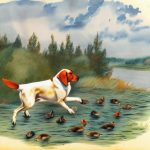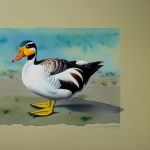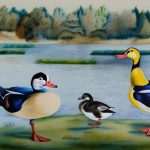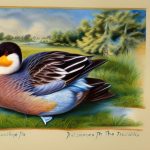Call ducks are a unique and charming breed of domestic duck that has been popular for centuries. They are known for their small size, distinctive vocalizations, and friendly disposition. Call ducks are often kept as pets, for exhibition, and for their ability to act as decoys in hunting. They are also valued for their high egg production and delicious meat. Call ducks come in a variety of colors, including white, gray, and brown, and they have a distinctive upright stance and a compact, rounded body. These ducks are a joy to watch and interact with, making them a favorite among duck enthusiasts.
Call ducks are named for their distinctive “call” or vocalization, which is a high-pitched and rapid quacking sound. This unique trait has made them popular for use as decoys in hunting, as their calls can attract other ducks to the area. Call ducks are also known for their friendly and sociable nature, making them a popular choice for those looking for a pet duck. They are often kept in pairs or small groups and can be quite entertaining to watch as they interact with each other and their human caretakers. Call ducks are also known for their high egg production, making them a valuable addition to a small farm or homestead. With their charming appearance and endearing personality, it’s no wonder that call ducks have captured the hearts of duck enthusiasts around the world.
Table of Contents
Key Takeaways
- Call ducks are a small domesticated breed known for their distinctive “call” or “whistle” sound.
- Call ducks originated in the Netherlands and were used as decoy ducks for hunting.
- Call ducks are known for their small size, rounded bodies, and wide variety of colors.
- Breeding call ducks is important for preserving the breed and maintaining genetic diversity.
- Breeders should provide a suitable environment, proper nutrition, and regular health checks for call ducks.
The History of Call Ducks
The history of call ducks can be traced back to the Netherlands in the 1600s, where they were originally bred as decoy ducks for hunting. Their small size and distinctive vocalizations made them ideal for luring other ducks into traps or nets. Over time, call ducks became popular as pets and exhibition birds, and they were eventually imported to England in the mid-1800s. In England, call ducks were further developed and refined, leading to the establishment of breed standards and the recognition of different color varieties.
Call ducks were first exhibited at poultry shows in England in the mid-1800s, and they quickly gained popularity among breeders and enthusiasts. They were prized for their small size, attractive appearance, and friendly disposition. Call ducks were also valued for their ability to lay a large number of eggs, making them a practical choice for small-scale egg production. Today, call ducks are still popular for exhibition and as pets, and they continue to be valued for their unique traits and charming personalities.
The Characteristics and Traits of Call Ducks
Call ducks are known for their small size, with drakes typically weighing around 1-1.2 pounds and hens weighing slightly less at 0.9-1 pound. They have a distinctive upright stance and a compact, rounded body. Their bills are short and slightly upturned, giving them a cute and endearing appearance. Call ducks come in a variety of colors, including white, gray, blue fawn, pastel, butterscotch, and snowy. They have bright orange legs and feet, and their eyes are dark brown.
One of the most distinctive traits of call ducks is their vocalizations. They have a high-pitched and rapid quacking sound that is quite different from the typical quack of other duck breeds. This unique call has made them popular for use as decoys in hunting, as it can attract other ducks to the area. Call ducks are also known for their friendly and sociable nature. They enjoy interacting with their human caretakers and can be quite entertaining to watch as they waddle around and interact with each other.
The Importance of Breeding Call Ducks
Breeding call ducks is important for preserving the unique traits and characteristics of this charming breed. As with any domestic animal, breeding call ducks allows breeders to maintain and improve the breed standard, ensuring that call ducks continue to exhibit the traits that make them so special. Breeding also allows for the development of new color varieties and the improvement of desirable traits such as egg production and temperament.
In addition to preserving the breed standard, breeding call ducks is important for maintaining genetic diversity within the population. By carefully selecting breeding stock and avoiding inbreeding, breeders can help prevent the loss of genetic diversity that can lead to health problems and reduced fertility. Breeding call ducks also allows for the continuation of the breed’s long history and tradition, ensuring that future generations can continue to enjoy these delightful birds.
Tips for Breeding Call Ducks
Breeding call ducks requires careful planning and attention to detail to ensure the health and well-being of the birds. When selecting breeding stock, it’s important to choose birds that exhibit the desired traits and characteristics of the breed standard. This includes considering factors such as size, color, conformation, and temperament. It’s also important to avoid breeding closely related birds to prevent genetic issues.
Proper housing and nutrition are essential for successful breeding. Call ducks should be provided with a clean and spacious living environment that includes access to fresh water for swimming and bathing. A balanced diet that includes a high-quality commercial duck feed supplemented with fresh fruits and vegetables will help ensure that breeding birds are healthy and in good condition.
Breeding call ducks also requires careful management of breeding pairs and eggs. Breeding pairs should be introduced gradually to allow them to bond before mating occurs. Once eggs are laid, they should be collected daily and placed in an incubator or under a broody hen for hatching. Proper care and attention during incubation will help ensure a successful hatch.
Common Challenges in Breeding Call Ducks

Breeding call ducks can present several challenges that breeders should be prepared to address. One common challenge is fertility issues, which can occur due to factors such as age, health, or environmental stress. It’s important to carefully monitor breeding pairs and seek veterinary advice if fertility issues arise.
Another challenge in breeding call ducks is ensuring proper incubation and hatching of eggs. Incubation requires careful attention to temperature, humidity, and turning of the eggs to ensure successful hatching. Breeders should be prepared to address issues such as infertility, poor hatch rates, or hatching difficulties.
Maintaining genetic diversity within the breed is another challenge in breeding call ducks. Careful selection of breeding stock and avoidance of inbreeding is essential for preserving genetic diversity and preventing health issues associated with inbreeding.
Conclusion and Resources for Call Duck Breeders
In conclusion, call ducks are a delightful and charming breed that has captured the hearts of duck enthusiasts around the world. Their small size, distinctive vocalizations, and friendly disposition make them a popular choice for pets, exhibition birds, and practical egg production. Breeding call ducks is important for preserving the unique traits and characteristics of this special breed, as well as maintaining genetic diversity within the population.
For those interested in breeding call ducks, there are many resources available to provide guidance and support. Local poultry clubs and breed associations can provide valuable information on breed standards, breeding practices, and resources for obtaining quality breeding stock. Online forums and social media groups are also great places to connect with other breeders and enthusiasts to share knowledge and experiences.
By carefully selecting breeding stock, providing proper housing and nutrition, managing breeding pairs and eggs, and addressing common challenges, breeders can help ensure the health and well-being of call ducks while preserving their unique traits for future generations to enjoy. With dedication and care, breeding call ducks can be a rewarding experience that contributes to the preservation of this beloved breed.
If you’re a duck breeder looking to expand your knowledge on poultry farming, you might be interested in an article on turning a shed into a chicken coop. This insightful piece from Poultry Wizard provides valuable tips and guidance on creating a suitable environment for your feathered friends. Check out the article here to discover how you can optimize your space for optimal duck breeding.
FAQs
What is a call duck breeder?
A call duck breeder is someone who specializes in breeding and raising call ducks, a small breed of domestic duck known for their distinctive “call” or quack.
What is the purpose of a call duck breeder?
The purpose of a call duck breeder is to produce healthy, high-quality call ducks for various purposes, including as pets, for exhibition, and for conservation of the breed.
What are the characteristics of call ducks?
Call ducks are small, compact ducks with a rounded head, short bill, and a distinctive “call” or quack. They come in a variety of colors, including white, gray, blue, and pastel shades.
What does a call duck breeder do?
A call duck breeder is responsible for selecting breeding stock, caring for ducklings, providing proper nutrition and housing, and ensuring the overall health and well-being of the ducks.
How can I find a reputable call duck breeder?
To find a reputable call duck breeder, you can search online for breeders in your area, attend poultry shows and exhibitions, or ask for recommendations from other duck enthusiasts or breed clubs. It’s important to do thorough research and ask questions before purchasing ducks from a breeder.
Meet Walter, the feathered-friend fanatic of Florida! Nestled in the sunshine state, Walter struts through life with his feathered companions, clucking his way to happiness. With a coop that’s fancier than a five-star hotel, he’s the Don Juan of the chicken world. When he’s not teaching his hens to do the cha-cha, you’ll find him in a heated debate with his prized rooster, Sir Clucks-a-Lot. Walter’s poultry passion is no yolk; he’s the sunny-side-up guy you never knew you needed in your flock of friends!







